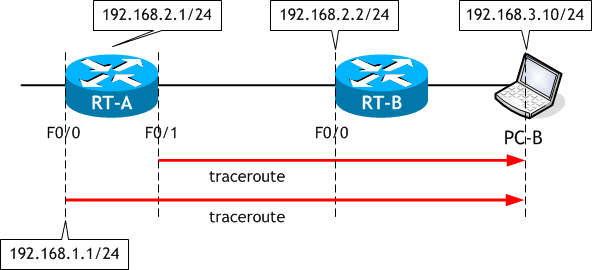標準tracerouteと拡張traceroute
※ 前の「シナリオ」の続きとして記載しています。
ネットワーク構成図

- RT-B の F0/1 にIPアドレス 192.168.3.2/24 を設定しなさい。
- RT-A と RT-B に次の通り追加設定しなさい。
- PC-B に、ネットワーク構成図に示す通り設定しなさい。
- RT-A からPC-B へ ping を実行しなさい。
- RT-A からPC-B へ TraceRoute を実行しなさい。
- 送信元IPアドレスとして 192.168.1.1 を使用し、RT-A から PC-B へ 拡張 traceroute を実行しなさい。
< RT-B > RT-B# conf t Enter configuration commands, one per line. End with CNTL/Z. RT-B(config)# int f0/1 RT-B(config-if)# ip add 192.168.3.2 255.255.255.0 RT-B(config-if)# no shut RT-B(config)# ^Z RT-B#
< RT-A > RT-A# conf t Enter configuration commands, one per line. End with CNTL/Z. RT-A(config)# ip route 192.168.3.0 255.255.255.0 192.168.2.2 RT-A(config)# ^Z RT-A#
< RT-B > RT-B# conf t Enter configuration commands, one per line. End with CNTL/Z. RT-B(config)# ip route 192.168.1.0 255.255.255.0 192.168.2.1 RT-B(config)# ^Z RT-B#
この設定内容は別のラボ・シナリオで行いますので、ここではこの通り設定してください。
< PC-B > C:\> netsh interface ipv4 set address "イーサネット" static 192.168.3.10 255.255.255.0 192.168.3.2 C:\> ipconfig Windows IP 構成 イーサネット アダプター イーサネット: 接続固有の DNS サフィックス . . . . .: IPv4 アドレス . . . . . . . . . . . .: 192.168.3.10 サブネット マスク . . . . . . . . . .: 255.255.255.0 デフォルト ゲートウェイ . . . . . . .: 192.168.3.2 C:\>
< RT-A > RT-A# ping 192.168.3.10 Type escape sequence to abort. Sending 5, 100-byte ICMP Echos to 192.168.3.10, timeout is 2 seconds: !!!!! Success rate is 100 percent (5/5), round-trip min/avg/max = 28/28/32 ms RT-A#
< RT-A > RT-A# traceroute 192.168.3.10 Type escape sequence to abort. Tracing the route to 192.168.3.10 VRF info: (vrf in name/id, vrf out name/id) 1 192.168.2.2 0 msec 0 msec 0 msec 2 192.168.3.10 4 msec 0 msec * RT-A#
TraceRoute は正常に完了しています。
TraceRoute を使えば、送信元 (RT-A) から宛先 (PC-B) までの経由がわかります。
この traceroute の結果からはわかりませんが、RT-A から発信された traceroute パケットは、送信元IPアドレスとして「パケットがルータを離れる際に使用するインターフェイス」である F0/1 に設定した 192.168.2.1 を使用しています。
拡張 ping と同様に、送信元IPアドレスとして F0/0 に設定した 192.168.1.1 を使いたい場合は拡張 traceroute を使用します。

TraceRoute を使えば、送信元 (RT-A) から宛先 (PC-B) までの経由がわかります。
この traceroute の結果からはわかりませんが、RT-A から発信された traceroute パケットは、送信元IPアドレスとして「パケットがルータを離れる際に使用するインターフェイス」である F0/1 に設定した 192.168.2.1 を使用しています。
拡張 ping と同様に、送信元IPアドレスとして F0/0 に設定した 192.168.1.1 を使いたい場合は拡張 traceroute を使用します。

< RT-A > RT-A# traceroute ← traceroute のみ入力 Protocol [ip]: ← Enter キー Target IP address: 192.168.3.10 ← 宛先IPアドレスを指定 Source address: 192.168.1.1 ← 送信元IPアドレスを指定 Numeric display [n]: ← Enter キー Timeout in seconds [3]: ← Enter キー Probe count [3]: ← Enter キー Minimum Time to Live [1]: ← Enter キー Maximum Time to Live [30]: ← Enter キー Port Number [33434]: ← Enter キー Loose, Strict, Record, Timestamp, Verbose[none]: ← Enter キー Type escape sequence to abort. Tracing the route to 192.168.3.10 VRF info: (vrf in name/id, vrf out name/id) 1 192.168.2.2 0 msec 0 msec 0 msec 2 192.168.3.10 4 msec 0 msec 4 msec RT-A#
RT-A# traceroute 192.168.3.10 source 192.168.1.1 ← source オプションで、送信元IPアドレスを指定
Type escape sequence to abort.
Tracing the route to 192.168.3.10
VRF info: (vrf in name/id, vrf out name/id)
1 192.168.2.2 0 msec 0 msec 0 msec
2 192.168.3.10 4 msec 0 msec 4 msec
RT-A#
また、拡張 ping 同様に、拡張 traceroute も特権モードでしか実行できません。
RT-A> traceroute 192.168.3.10 ← 標準 traceroute
Type escape sequence to abort.
Tracing the route to 192.168.3.10
VRF info: (vrf in name/id, vrf out name/id)
1 192.168.2.2 0 msec 0 msec 0 msec
2 192.168.3.10 4 msec 0 msec *
RT-A>
RT-A> traceroute ← 拡張 traceroute
% Incomplete command.
RT-A>
ユーザモードで実行できるのは標準 traceroute なので、当然オプションの指定はできません。
RT-A> traceroute 192.168.2.2 ? ← オプションの指定はできない
<cr>
RT-A> traceroute 192.168.2.2
また、拡張 ping 同様に、拡張 traceroute も一行で入力することができます。